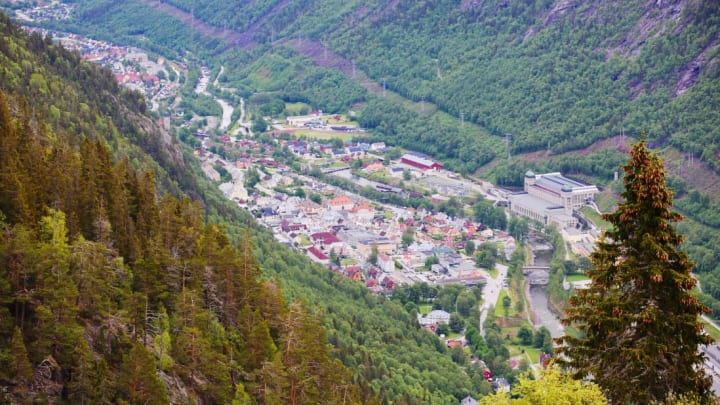During the winter months, residents of Rjukan, Norway, can walk through the town’s market square and feel sunlight on their faces. This wouldn’t be noteworthy in most places, but in this part of the world, it’s miraculous. Rjukan is nestled in a mountain range that blocks the low, Arctic sun from late September through mid-March, and the only way for bright, natural light to reach the valley is through a system of giant mirrors.
For the first century of its history, Rjukan spent half the year in dreary dimness. Norway sits just below the Arctic Circle, and at such high latitudes, the sun appears to hug the horizon for the duration of the short, winter days. But that wasn’t the only problem keeping Rjukan in the shade. Norwegian engineer Sam Eyde founded the town in the Vestfjord valley in the early 20th century to accommodate workers at his new hydroelectric power plant. The location was conveniently close to the Rjukanfossen waterfall that fed the plant, but it came with a major drawback: The sheer mountains to the north and south cast a gloomy shadow on residents.
The negative effects of living in the sun-starved region were apparent right away. Rjukan winters aren’t totally dark, but they do lack the warmth and brightness of life outside the valley. In 1913, Eyde first proposed building a massive mirror to harness and redirect sunlight to townsfolk in the winter, but the project didn’t make it past the conception stage in his lifetime. As an alternative solution, a gondola was built to transport citizens out of the valley and into the mountains where they could soak up some much-needed vitamin D. The cable car (called the Krossobanen) still functions today.

In 2005, artist and town resident Martin Andersen was struck by the same idea Eyde had nearly 100 years earlier. The difference this time was that a giant sun mirror was no longer a futuristic concept. Such mirrors were used for various purposes around the world, but instead of growing plants or generating energy, Andersen wanted to build mirrors that recreated the simple feeling of walking through a sunbeam.
After securing financial support from the town and teaming up with engineer Jonny Nersveen, Andersen made his dream a reality in February 2013. That’s when three 183-square-foot sun mirrors—or solspiels—were placed on a mountain 1475 feet above Rjukan. Controlled by a computer hundreds of miles away in Bavaria, the solar-powered rig slowly turns throughout the day to capture the maximum amount of the sun’s rays. The mirrors are positioned to reflect light into the market square below at 80 to 90 percent the strength of direct sunlight. Since they were installed, the town center has acted as a sunny sanctuary for residents in the dead of winter.
The solspiels made Rjukan famous, but that’s not all the town has going for it. Its scenic location makes it a popular spot for hiking, skiing, and snowshoeing. It’s also home to the annual Rjukan Ice Festival, which welcomes ice climbers of all levels to scale the area’s stunning frozen waterfalls. But even on the quietest winter days, locals and visitors can stroll to the town square to experience something as ordinary as the warmth of the sun in a way that’s unique.
